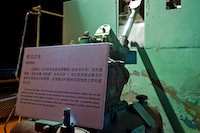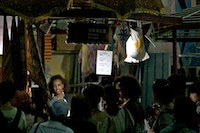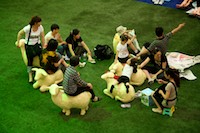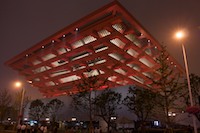Today, eventually, was my first day at the Expo. My plan was to start in the late morning on the PuXi side, which supposingly was less crowded, and move over to the PuDong side only in the late afternoon, hoping that in the evening pavillion queues get shorter. Basically, I followed the area letters in reverse order, starting with E and planning to move all the way to A. The pavillions with the longest queues are all in A – Asia, which I would reach in the evening only. Than plan was good and I would recommend it again. I only spent a bit too much time in E and D, the PuXi side. Next time I switch over earlier.
People told me that there are few foreigners only, some 95% of the visitors would be Chinese. What a lie, absolutely not true! It’s 99,5% Chinese! It’s so few foreigners that I could make a drink vendor together with another customer gaze in astonishment with just 3 syllables of Chinese to order a bottle of water.
PuXi

I picked gate 2 as it is conveniently located on the PuXi side next to a line 4 metro stop. You can’t accuse the Expo that they can’t deal with masses of people, only not with a few 😉
We had to walk through this entire labyrinth of waiting queue, though at 10:43 nobody was waiting. Entry was highly efficient. And after I drank half of my water bottle under the watchful eyes of a security guard, who has seen the liquid on the X-Ray, I was granted access. With the rest of the water.

At first the area looked extremely empty, only few people around. The impression changed only when reaching the first exhibition halls, like this one of the CSSC pavillion (haven’t figured out what CSSC stands for). Even without Chinese character knowledge you could sense that this is the indicated waiting time for entry to the CSSC pavillion. And with you know for sure 😉
I walked along, already feeling the extremely hot and humid weather, starting to think “what the h…” shall I do here all day. It’s obvious: Sooner or later you simply have to get into some of the pavillions to flee the outside heat. The first one with a queue of reasonable size was the “Pavillion of Future“.
Far Left: The Pavillion of Future starts with a rough overview of “old” utopias of what the world could look like in hundred or thousand years. Movie scenes or books were the most prominent sources. Here, some information is displayed using LCDs with a book metapher. But it was certainly a great toy for children to “flip” the pages. I had a hard time reading at least some words before the page got turned over again.
Left Center: Oh, I love the Chinese display explanations. They are always so kind not only to tell you what you see, but also what you shall think and even feel! That always makes my museum life so much easier in China. I really would have been in doubt if I shall think “what the h… has this old rubbish to do with city development” or “that reminds me of the city’s campaign to better itself”. The text told me!
Right Center: How shall I call it? Main hall? Main entertainment hall? It was loud, it was colorful, it presented some ideas in a comic-like video at the far wall.
In the left corner, not visible on this photo, was a though-provoking display of video sequences, which present what life could look like with virtual or tele-presence. Little scenes like a “global-wide concert” with youngsters taking part virtually, running out of telepresence credit and having her grandma to ask to give them some 😉
The other was more gruesome, at least to me, I’m honestly unsure if it was meant to warn or to promote telepresence: A wedding party, all guests, the wedding couple included, were “there” only virtually. Might be fun to have some celebrities invited as part of the party package…but seeing the wedding couple go to individual beds far away from each other, coupled only by some telepresence device, is too modern a thought to me. They didn’t exactly explain that detail about the children-making…
Far Right: The devices shown here are state of the art, but are there and working and might as well impact the near future. All of them Chinese-made:
Left: Digital paper (known from devices like the Kindle)
Center: 3D television without the need for sepcial glasses
Right: Laser-beamer, a super-tiny device the size of a cigarette pack.

Very good pick for a start! i Moved on a bit, entering an area of several smaller pavillions and halls shared by city “cases”. This one here is the pavillion of the french region of Alsace. It presented some text and photos on the region in there nice pavillion, which also features some sophisticated water-fed clima-regulating glass front. Unfortunately, explainations were mainly in Chinese and French only 🙁
But a Chinese volunteer made me quite OK a crêpe 🙂
Left: This was a top floor feature of a pavillion for one of the China regions (NingBo TengTou). (Sidenote: There is this huge China pavillion, which hosts all provinces, so an individual privonce pavillion is a rare thing.)
Architecture and idea was quite nice! Here on the top floor they commemorated their ancestial heritage. In front of this paddy was a sign saying something about the finding of some 7000 years old rice seeds, though it wasn’t clear if the rice crops here are from those ancient seeds.
In the lower floors was a weird experience: You were asked to lie down on the floor and watch a video projected to the room’s ceiling, while underneath you some air cushions blew up. Maybe I lay in a non-optimal position…but to me it was rather uncomfortable, maybe it was supposed to lay your feet upon the bump.
Right: It was so hot and humid in Shanghai that fishes could swim in the air.
Left: The Madrid pavillion gave some excellent insight into urban planning and the general ideas behind it. If, that is, you were to read semi-long texts. As far as my visit was concerned I was the only one, let this display serve as an example: An excellent view on the idea of moving the central motorway underground beneath the river, indicating the freed up spaces on the top layer and the road layout on the bottom layer. But to understand the genius behind it you had to read the accompanying texts (unlike in Alsace it was also provided in English ;)) Few Chinese found the time and instead ran through and out.
Right: A pavillion next to Madrid, apparently Chinese-thought and operated, took a completely different approach: Instead of bothering to write long texts they let people enter the exhibition of a lot of rooms with vision on their future interieur only as guided group tours. That means: There was a guide in front explaining the displays and rooms, trying to keep the group interested. Didn’t serve me any purpose as he spoke Chinese only. So I walked ahead through the exhibition but without explanatory texts was quickly lost. While everything was quite modern and nice I missed the break-through ideas. This photo presents an “elderly lounge”, the video in the back showing off two major attractions: The ancient-style bed in the back with some sensors for some kind of medical conditions (couldn’t make out which ones in the Chinese blabber) and the digital tablet on the desk, which, as you can see in on the video panel, can be hand-written on. Great, a break-through!
The pavillion’s idea was great, design as well. Now add a few background info and it would be amongst the best. But only to Chinese visitors.
Left: A portrait with the Bremen Musicians…or at leasts its donkey 😉 Bremen had a big stall in one of the shared city halls on the PuXi side. Displays were a good mix of something to see and touch, combined with information panes. Suited to both Chinese and Western visitors. Unlike, I must admit, the Freiburg stall next door, which was too information overloaded. Even I skipped it.
Center: Isn’t she cute? Chinese really have the right touch when it comes to cute portrait poses. Just a lucky moment when exiting the Bremen stall. She’s sitting on a park bench quoting a Heinrich Heine poem about love. Love to the fatherland, that is 😉
Right: Another good example of how to catch Chinese’s attention in the, I believe, Montreal stand: After watching a 3D movie on the huge landfill in the city’s center and how to recultivate it, a Chinese guide welcomes the group of people exiting from the cinema to explaing the displays. I had to read the excellent texts myself, but that way everybody was catered for.
Left: A praise on the volunteers! They were virtually everywhere. Available to all people with all kinds of questions: The Expo volunteers. Often I saw them waiting at corners and under sun umbrellas. But as often I saw them in discussion with visitors. I’m positive they made the life of many visitors a lot simpler with their kind and free help. And, just noticing now…isn’t that the Heinrich Heine cutie in the background again…?
Center: Well…China Railway names their train differently, forgot the exact letters, but it also ended on 3. As it basically IS a German ICE3, which unfortunately is not mentioned anywhere. The displays sound like it’s their invention. Never mind. The China Railway pavillion was highly interesting due to the excellent information on the railway enhancement program throughout the country. i skipped the movie theater and instead read the displays. And later downstairs there were two simulators, this one even live operated. Surprisingly (? that’s a Western preconception) by a woman. The train will operate the newly built Shanghai-Beijing line at up to 350km/h.
Right: “Do not rely on” Still, you can come across some really fine mistranslations 😉
I found the ferry service very reliable (though the sign certainly is about the handrail). And the LCD displays inside inform you about the great effort the ferry company has undertaken to bring these vessels to you! I was for a few moments surprised to learn that the ship company collaborated with the Amusement Equippment Company and thought it’s another mistranslation until I understood: That Amusement Equippment Company built huge amusement park devices like roller coasters and ferris wheels. They definitely do know about how to treat steel.
Somewhere inbetween, it was afternoon by now, I had a quick eat at Pizza Hut, the only reasonable option on the PuXi side. On the PuDong side, with many pavillions offering some bites of their local food, the food situation is quite a bit better. And if you are into Chinese eateries, then don’t worry at all…they are verywhere 😉
PuDong
Arriving on the PuDong side I still longed for a coffee, feeling a bit tired by now. Enters the shared hall for Africa:
Left: Getting a decent cup of coffee is quite a challenge. The Ethopian store has some and cheap! Though it wasn’t the best I’ve ever had it was definitely well-brewed coffee. (There is a Starbucks, I learned later from the maps, near the US pavillion…where else?)
Center: The Expo is actually a gigantic stamp chasing game, all the rest…the buildings…the ideas…the people…the effort…all staffage. Somewhere you can get these Expo passports and have it stamped, supposingly at the pavillions and places you visited. There is even some advantage when having collecting some stamps for the entry at some (very) few pavillions, I’ve read. Other than that it’s just for fun.
I felt pity for the poor volunteers operating the pavillions’ stamps, especially in the joint African hall where there are may smaller booths, one per country, an easy prey for stamp hunters as nearly every booth offered a stamp.
Pictured here is the Ivory Coast booth. The queue (here and everywhere else in the Africa hall) only serves the stamping counter. I always passed by when I wanted to see the displays.
The poor lad here even tried to teach the Chinese how to speed up the process by orderly laying out the passports in front of him, but all he got in response was some loud shouting.
I had a talk with the Togo lady who was all fed up by this stamping business, had the Chinese do the stamping on their own and fled to me to explain me Togo’s past and future, which the Chinese stamp hunters completely ignored. Poor lady.
A good idea gone mad.
Right: The ladies here at the Lithuania pavillion (obviously no longer Africa) take it humorously…the only way that works over hours…and started treating the Chinese stamp hunters like children. That at least works.
Left: The Netherlands – Definitely one of the most colorful and enjoyable “pavillions”.
Center: Chinese are dedicated flower photographers. It doesn’t matter then, that this Netherlands’ tulip field is all plastic 🙂
Right: These sheep received some media coverage due to the fact the quite some of them are broken by now already. They are indeed ment to rest on them as this group of families does. But apparently some had been treated quite harshly, lost their ears or are entirely broken by now. I’ve not seen evidence for such rudeness.
Left: The main attraction of the UK pavillion. Can’t tell you (yet) what this is supposed to be as I did not intend to wait for hours for access.
Center: Eastern Europe – Seen from the Netherlands’ pavillion: Romania (the globe), Russia (the white towers in the back) and Croatia (the red one to the right).
The lower bamboo/white one is a German-Chinese collaboration pavillion on a game about the future of city life. Haven’t been in, though.
Right: Licensed Product Boxes – Looks like good business today.
Left: Again (as during the Expo in Germany), Estonia surprised with few actual country displays but a cute idea: They collected ideas from the visitors in some 37 pigs, each of it on a different environment question. People could SMS their suggestions and take part in a lucky draw every 10 minutes (I didn’t win) and just follow their love of portrait photography.
Center: Expo Axis.
Right: That all-to-famous China pavillion. I only passed by. It is indeed impressive from the outside.
But I had long started to worry about feet, me being tired, the time till closing, and the way back. That’s why comments on the axis and China are so brief and section A – Asia is missing completely. Apparently, I’ve also not picked any photo of the New Zealand pavillion, which features the Maori canoe we saw during its making in Rotorua. While nice from the outside the pavillion is kinda saying nothing in its inside.
So I walked out of exit 6 together with thousands of Chinese, took the subway 8 back into the city and home. Where I pretty quickly fell asleep, letting the site update business wait until the next day.
I will go to the expo once more, hopefully together with Nina. Maybe this Sunday, maybe the next. And then we will definitely spend some more time in Asia.
Today’s Lesson: It’s a passport stamp hunting game.
Categories: Shanghai
Originally Created: 06/18/2010 09:00:25 AM
Last Edited: 06/18/2010

























